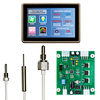 The industry's most authoritative handbook on flow measurement provides a road map to the field of flow measurement. This best-seller discusses strategies for problem solving and puts the whole array of types of flowmeters at the reader's disposal. The text includes laminar flow elements, critical flowmeters, statistics for measurement, laboratory primary standards, and uncertainty in flow measurement. Emphasis is placed on the importance of accuracy in measurements and ways of ensuring accuracy and avoiding equipment damage through correct forecast of operating conditions, flowmeter selection, installation, calibration, and maintenance. Fundamental considerations such as mixed-phase flow, piping effects, and flow conditioning are examined at length. The problem of attaining a meaningful flow signal through linearization, compensation, and totalization is discussed. Join the thousands of engineers, technicians, managers, and salespeople that have found this reference text an invaluable resource.
The industry's most authoritative handbook on flow measurement provides a road map to the field of flow measurement. This best-seller discusses strategies for problem solving and puts the whole array of types of flowmeters at the reader's disposal. The text includes laminar flow elements, critical flowmeters, statistics for measurement, laboratory primary standards, and uncertainty in flow measurement. Emphasis is placed on the importance of accuracy in measurements and ways of ensuring accuracy and avoiding equipment damage through correct forecast of operating conditions, flowmeter selection, installation, calibration, and maintenance. Fundamental considerations such as mixed-phase flow, piping effects, and flow conditioning are examined at length. The problem of attaining a meaningful flow signal through linearization, compensation, and totalization is discussed. Join the thousands of engineers, technicians, managers, and salespeople that have found this reference text an invaluable resource.
Chapter 10 - Laminar Flow Elements
Laminar flow elements, also known as LFEs, laminar flowmeters, or simply
laminar meters, are used to measure the flow of gases through closed conduits.
They operate by producing a differential pressure that is proportional to the velocity
of the gas passing through an elongated section of fixed cross-sectional area.
Since the pressure drop across this section is a function of the average gas velocity
within it, a relationship between pressure drop and actual volumetric flow rate (the
product of average velocity and area) can be obtained. Many different styles and
designs have been produced over the years by a growing number of manufacturers.
Standard models are available with full-scale volumetric flow rate ranges
from as low as 0.5 cm3/min to over 2000 ft3/min (1 m3/s). Laminar flow elements
are used in production processes, incorporated into test stands of various types,
and are particularly well suited for use as transfer standards for the calibration of
other gas flowmetering devices.
While they belong to the differential pressure class of flowmeters, laminar
meters are unique in two respects. First of all, the differential pressure they produce
is proportional to volumetric flow rate, as opposed to the square of the flow
rate. The almost linear relationship between flow rate and differential pressure is
the distinguishing feature of all laminar flow elements. The other issue that sets
them apart from orifice plates, subsonic Venturis and nozzles, for example,
involves the manner by which the relationship between flow rate and differential
pressure is determined. Unlike conventional differential pressure flowmeters,
there are no standardized designs or published performance tables for laminar
flowmeters. Due to their rather complex internal geometry, laminar meters require
individual flow calibrations to determine their precise characteristics.
Even so, once calibrated, the operation of laminar flow elements is well understood The turndown range, as well as the overall flow rate measurement uncertainty
| Advantages:
Disadvantages:
|
 TABLE OF CONTENTS
TABLE OF CONTENTS 






